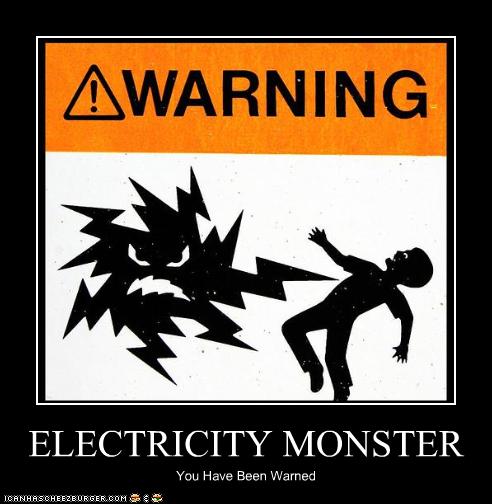Before starting any experimentation, even if it’s just prototyping on breadboards you need to think about…
- Seeing yourself as a giant resistor. Sounds a bit silly right? It’s true though, the human body does have some resistance to electric current. To stay as safe as you can when working with electronics you need to think about the stuff then can increase or decrease that resistance. If you’ve got sweaty hands, lots of metal jewellery on and are standing in a puddle you’re not really in a good position to be using electricity! Normally the human body has a resistance of anywhere between 50,000 to 1,000,000 ohms (the range is so big as it depends on body chemistry, path that resistance is measured over etc.) if you’re in the situation above you can have lowered that resistance to to as low as 100 ohms!
- Electricity can really hurt! when electricity comes into contact with a person’s body it can cause intense muscle contractions and generate a high heat at the contact point. If the current is strong enough this can cause heart attacks and 3rd degree burns. It may be fun to tinker with circuitry but never forget the effects that the power running through them can have. You should never run circuits from mains electricity until you are really experienced, AC current (mains: 240V) ignores everything in the point above and treats your body as a giant capacitor! The metal you touch is one plate and the tissue under underneath your skin is the other with your skin itself acting as the dielectric. Voltage shocks this high can burn right through your skin. So, no mains experiments.
- Static is bad, and not just for your ICs, some components can store a charge. Capacitors for example, are designed to hold a static charge, if you don’t discharge a capacitor properly it can shock you. With little capacitors this can be annoying but larger ones used in power supplies can store a lethal charge. To discharge a capacitor properly place a bulb across it’s terminals using insulated crocodile clips,you’ll be able to see when it has discharged as the bulb will go out. If you don’t have a bulb handy put a 10K resistor across the terminals and wait at least 30 seconds. You can check the discharge using a multimeter.
Here’s a good electricity safety check you should do before starting any work:
Make sure you have
- a dry working surface.
- a dry floor.
- dry hands or gloves to wear.
- removed any rings, watches or other jewellery.
- a first aid kit, phone and preferably a friend close at hand

